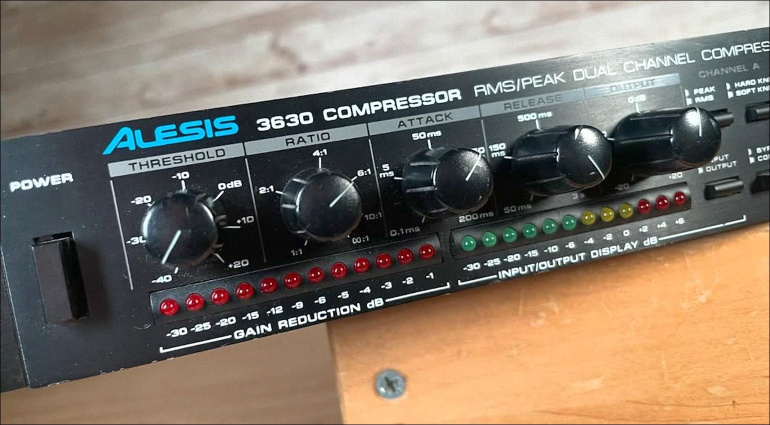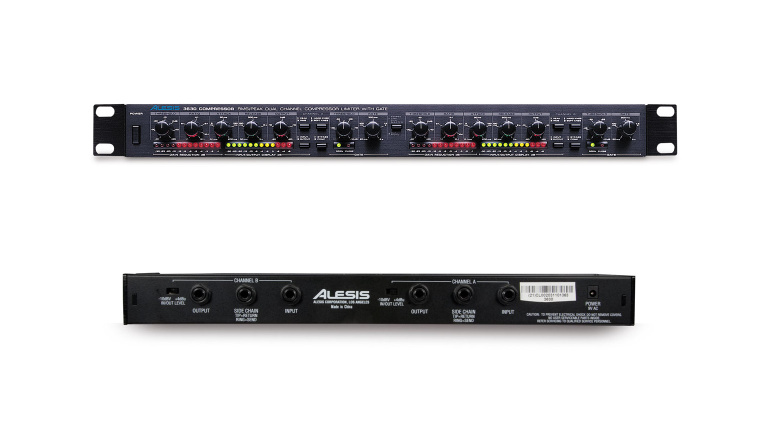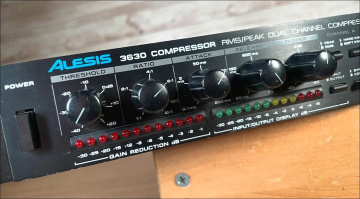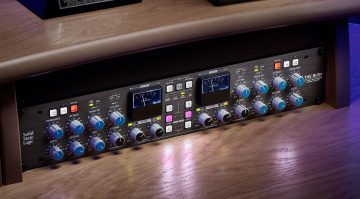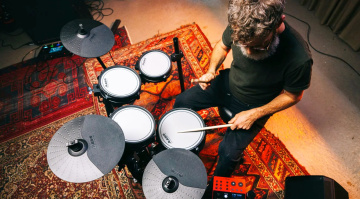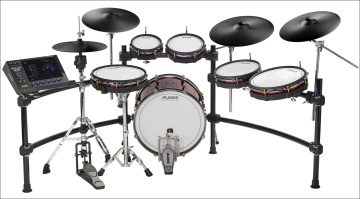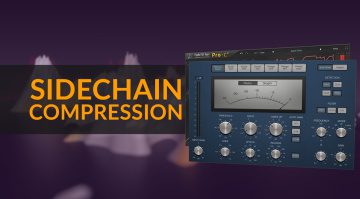Alesis 3630: The Daft Punk Compressor
Get the famous ducking effect from French house music.
This budget stereo compressor/limiter/noise gate became synonymous with the sound of French House. We find out how to use the Alesis 3630.
In this Article:
The Alesis 3630 Compressor/Limiter
The Alesis 3630 was released in 1989 as an entry-level Swiss army knife compressor for home recording. With dual-mono or stereo-linked operation and per-channel sidechain inputs, the rather utilitarian 3630 was useful for tasks like vocal de-essing.
However, the 3630 didn’t have any of the tasty, warm character one associates with classic compressors like the 1176 or the dbx 160. Instead, it became known for its harsh sonic character and even for introducing artifacts to the signal.
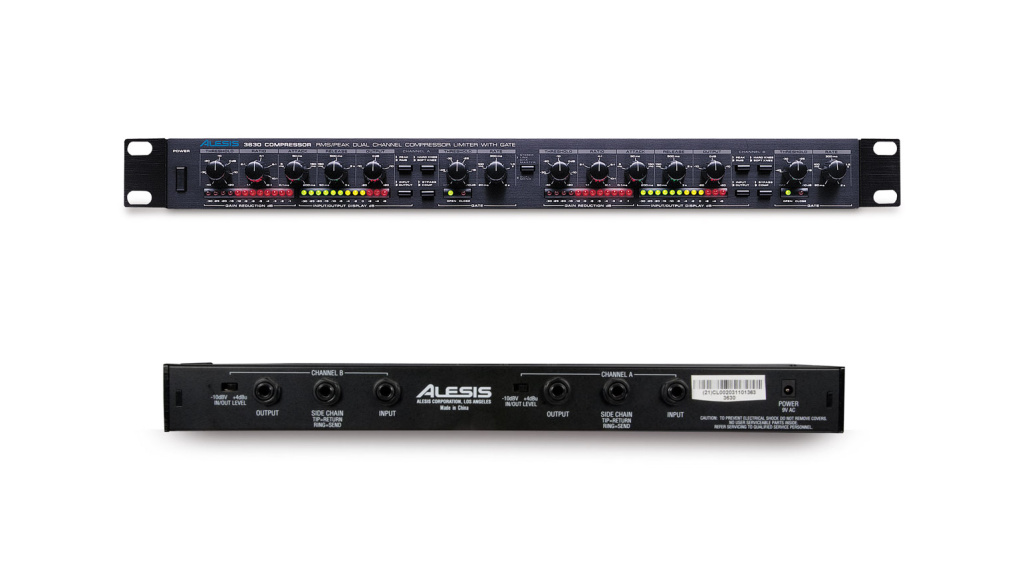
You see, one of the key design flaws of the 3630 was that the rather noisy noise gate circuit could not be bypassed unless you modified the circuitry, which became a popular practice. Regardless, a couple of French musicians named Thomas Bangalter and Guy-Manuel de Homem-Christo found the 3630 to have just the sonic aesthetic they were looking for.
When used within the context of Roland hardware synths and drum machines, and an S-760 sampler, the 3630 became a crucial part of the sound of classic albums like Homework (1996) and hits like Music Sounds Better With You (1998).

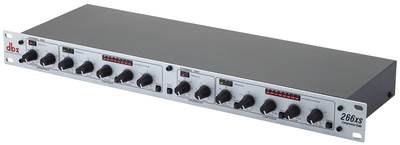
Alesis 3630: What Makes it Unique?
As we’ve mentioned briefly, the 3630 is a dual-channel dynamics processor with compressor/limiter and expander/gate functionality. Unlike many of the coveted classic compressor designs, the 3630 is not what you would call a character or vibe compressor. It does, however, provide basic dynamics shaping and signal management.
This purely functional approach made the 3630 appealing to artists within the blossoming French house movement in the 1990s. The sampler-based workflow of the production style and the lo-fi aesthetic allowed the 3630 to be used as a bus compressor or limiter when bouncing mixes to tape or the DAT machines that Daft Punk used.
Because the 3630’s behaviour was snappy and aggressive, it was ideal for four-on-the-floor electronic dance music, merging well with the gritty sound of French house. Also, the sidechain input allowed you to use the kick to trigger the compressor, for that classic ducking effect we know today in many styles of electronic music.


Alesis 3630: What is Sidechain Compression?
Before you put on your space helmet, you need to have a basic understanding of how sidechain compression works. On many hardware and software compressors, you’ll find a sidechain high-pass filter that functions using an internal detector signal. However, when we talk about sidechaining, we’re usually referring to the process of using an external signal to trigger the compressor, so let’s avoid the possible confusion.
Generally, a compressor is used to control the dynamic range of a signal by reacting when the level passes the threshold. On the other hand, sidechain compression uses a separate signal, which is often the kick drum, to cause the compressor to react and process synth pads, basslines, and the mix bus.
When you send a kick drum signal into the compressor’s sidechain input, which is also sometimes called a key input, the compressor responds by ducking the main input signal. As you pull the threshold control down further, you’ll notice that the pumping effect becomes more exaggerated, as we can hear on classic tracks like Around the World and Da Funk.

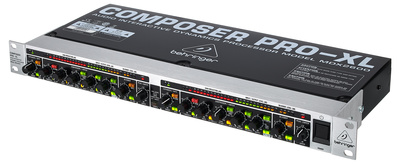
Alesis 3630: Signal Routing
Now, let’s run through the process of setting up the 3630 compressor for sidechaining, step-by-step. Remember that these techniques can be applied to the stock compressor in your DAW too, and you can add a bit reduction effect set at 12-bit to get that hardware sampler sound.
If you’re compressing your mix bus, make sure that stereo-link mode is active, as this will allow you to use the controls and sidechain input from channel 1 to alter both channels simultaneously as a single stereo group. Now that the compressor is ready, run your main mix outputs into the inputs and the compressor’s outputs into your speakers.
| Parameter | Value | Description |
|---|---|---|
| Ratio | 4:1 – 10:1 | Higher compression ratios emphasize pumping; Daft Punk often used 8:1 or higher. |
| Attack | 0.1 – 5 ms | A fast attack setting allows the kick to punch through instantly without affecting transients. |
| Release | 60,000 ÷ BPM = 1/4 note value | Set the pumping to match the tempo. |
| Threshold | 6 – 12 dB of gain reduction | Adjust until the kick is pumping audibly on every beat. |
| Sidechain Input | Kick Drum Channel | This causes the compressor to react with each note of the kick. |
| Output Gain | +2 to +6 dB (as required) | Restores the compressed signal to its original level |
| Mode | Stereo Link Active | Ensures a unified stereo effect. |
While the precise settings will depend on the characteristics of the signal being processed, let’s start with a template for Daft Punk-style sidechain compression. Set the compression ratio anywhere between 4:1 and 10:1, keeping in mind that higher ratios will produce a more pronounced pumping effect.
For the attack time, we want to set this fast to let the kick drum through instantaneously. To do this, you can set the attack between 0.1 – 5 ms, and turn the dial until you find the sweet spot that matches the feel of your track. A medium release time (100 – 500 ms) will shape the decay of the ducking, and we can also sync this to the tempo for the best results. (See settings table above)


Alesis 3630: The Finishing Touches
The threshold control is the key parameter for determining how much gain reduction is taking place. We want to start with around 6-12 dB of reduction, and we can then use our ears to hear that the compression is ducking nicely in time with the kick. Then, to compensate for the monstrous amount of compression, we can boost the output gain.
Here, we can listen to the level of the original kick drum signal and use it as a guide to find the best output gain level for the signal being processed. The key idea with this effect is for it to become an innocuous part of the music, so pay close attention to the phrasing in the drum groove.
We can ensure this by fine-tuning the release time to get the compressor’s ducking to work with the rhythm of the track. Notice how the effect stutters when the release time is too short, while it becomes languid when it’s too long. Also, listen carefully to the individual elements in the music to ensure that everything is hitting nicely.
Alesis 3630: What Else Can it Do?
The 3630 was famously used for sidechain compression, but it has other uses as well. For instance, if we use an aux send on a mixer, we can use the compressor as a parallel effect. This allows us to dial in rather severe compression settings and blend the dry and processed signals together to create a more gritty sonic texture.
What’s more, the 3630 can be used on drum loops to create choppy rhythmic effects using the expander/gate section. When working with a noise gate, you’ll notice that only the parts of the signal that are louder than the threshold become audible. This creates a stripped effect that can be effective when combined with compression.
Finally, the 3630 can also be used as your main bus compressor. This is particularly effective if you are using mostly hardware samplers, synths, and drum machines to create your sounds. That way, when you slam your mix, the sonic character should actually complement the sounds rather than destroying them.
More about the Alesis 3630:
- Official Product Page
- Thomann’s Guide to Compressors
- Learn to use the Altec RS124 (The Beatles’ Compressor)
- 3630 Mods
*Note: This article about outboard gear for beginners contains affiliate links that help us fund our site. Don’t worry: the price for you always stays the same! If you buy something through these links, we will receive a small commission. Thank you for your support!

 4,2 / 5,0 |
4,2 / 5,0 | 